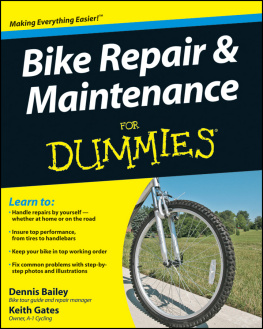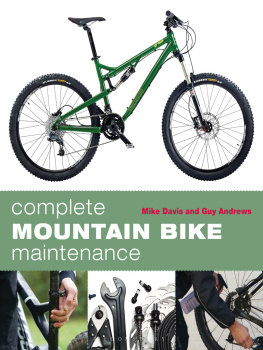Janssen Gerard - The Bike Repair Book
Here you can read online Janssen Gerard - The Bike Repair Book full text of the book (entire story) in english for free. Download pdf and epub, get meaning, cover and reviews about this ebook. year: 2021, publisher: Quadrille Publishing, Limited, genre: Home and family. Description of the work, (preface) as well as reviews are available. Best literature library LitArk.com created for fans of good reading and offers a wide selection of genres:
Romance novel
Science fiction
Adventure
Detective
Science
History
Home and family
Prose
Art
Politics
Computer
Non-fiction
Religion
Business
Children
Humor
Choose a favorite category and find really read worthwhile books. Enjoy immersion in the world of imagination, feel the emotions of the characters or learn something new for yourself, make an fascinating discovery.
- Book:The Bike Repair Book
- Author:
- Publisher:Quadrille Publishing, Limited
- Genre:
- Year:2021
- Rating:5 / 5
- Favourites:Add to favourites
- Your mark:
- 100
- 1
- 2
- 3
- 4
- 5
The Bike Repair Book: summary, description and annotation
We offer to read an annotation, description, summary or preface (depends on what the author of the book "The Bike Repair Book" wrote himself). If you haven't found the necessary information about the book — write in the comments, we will try to find it.
The Bike Repair Book — read online for free the complete book (whole text) full work
Below is the text of the book, divided by pages. System saving the place of the last page read, allows you to conveniently read the book "The Bike Repair Book" online for free, without having to search again every time where you left off. Put a bookmark, and you can go to the page where you finished reading at any time.
Font size:
Interval:
Bookmark:


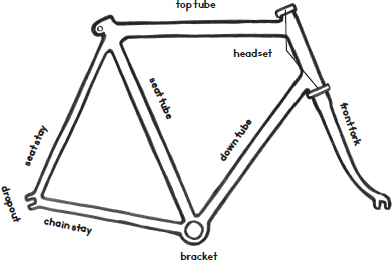
The frame is the spine of the bicycle, usually made of metal tubes. A frame consists of two parts. The front frame consists of an upper tube, a down tube a seat tube and a headset tube, into which the handlebars fit. The rear frame is made of thinner tubes. This is the triangular structure in which the rear wheel sits. A nice old-fashioned bike has a frame that you can dismantle. Newer bikes usually have a one-piece frame. Modern, expensiv bikes often have thick tubes, so they look robust and rugged, but this is just for show. Frames with thinner tubes can also be strong. A frame almost never needs to be repaired.
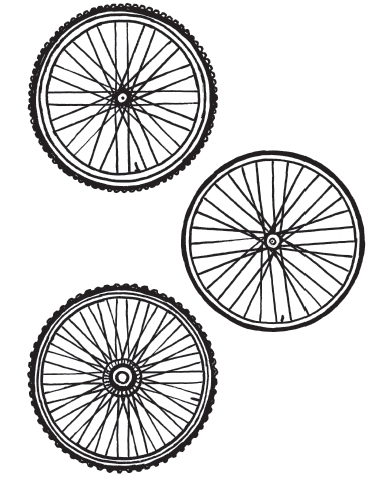
After the frame, the wheels are the most important parts of a bike. They are much more vulnerable than a frame. A bike wheel consists of a rim that is attached by spokes to a hub, which is a double cylinder. The outer and inner cylinders can rotate independently of each other. This is possible because tiny, round metal balls the ball bearings move around inside.
Bike wheels come in various sizes. The bigger the wheel, the less nuisance you suffer from bumps in the road. It has long been thought that a bike with larger wheels is more stable, due to the so-called gyroscopic effect: something that rotates wants to stay in its own plane (the same effect ensures that a spinning top does not fall over). But research has shown that this gyroscopic effect is not so important for the stability of a bike. Large wheels are therefore not necessary, especially if the road is flat, and you have good cycle paths. The further disadvantage of a large wheel is that it buckles more easily.
A rim is made of steel, aluminium or on older bikes chrome. The rim is U-shaped, so the tyre can rest inside it. Some rims are suitable for a so-called clincher tyre: an ordinary external tyre, with two internal steel wires that ensure the tyre grips the rim firmly. Racing bikes often have rims with a shallow bed, suitable for tubes, which are racing bike tyres without a steel wire. Tubes can be inflated more and ensure lower rolling resistance.
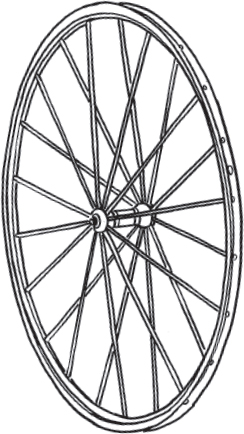

Most wheels have 36 spokes, although this can also be 32, 28 or 24. The more spokes, the stronger the wheel, but also the heavier the bike. Attaching spokes is called braiding or lacing. There are various spoke patterns in which you can arrange spokes in a wheel, such as the 1-over-4 spoke pattern, the 1-over-3 spoke pattern and the 1-over-2 spoke pattern.
It appears logical to insert the spokes directly from the centre outwards, so directly from the hub to the rim. This radial spoke pattern was common in the earliest bikes; however, when braking and driving the wheel, the forces are not transferred properly. Due to the flexibility of the spokes, the hub is able to turn slightly without the rim also turning. This does not happen if the spokes are crossed.

The last component of the wheel is the hub. In its simplest form, the hub consists of an axle, ball bearings and a hub body. The ball bearings allow the hub body a metal cylinder to rotate while the axis is still. The hub body is usually made of aluminium.
The ball bearings must be lubricated with a small amount of grease, in order to be able to do their job properly. The hub flange is the name of the upright edge of the hub body, which contains the holes for the spokes.

Most city bikes have upright handlebars. Its best when the handlebars are as wide as the riders chest. But there are no fixed rules. If you want to, you can fit huge clown handlebars to your bike, and ride around like a cool motorcyclist.
The handlebar system consists of an upper tube, the handlebars and the headset. The handlebars are not only important for steering but also for maintaining balance. The stability of a good bike has a lot to do with the interaction between the frame and the handlebars. Its a bit like how you can balance a broomstick on one flat hand, by moving your hand in the direction the broomstick falls. A bike balances itself in exactly the same way, because the handlebars fall quicker than the frame. As a result of this falling motion, the frame is pulled back upwards. If you give your bike a push and run alongside it, and give the bike a soft tap, you will see how it works and that the bike will right itself.
If youve lost the thread here, it doesnt matter. What is important is that you understand that a fully loaded basket on the front of the bike, or a jacket on your handlebars will make the bike a little less stable, because the interaction between the frame and the handlebars is disrupted.
A saddle consists of two components: the saddle itself and a saddle strap that attaches the saddle to the seat post. The seat post is the rod that is inserted in the frame. Sometimes, on older bikes, it becomes rusted solid. This is something to watch out for when purchasing a second-hand bike. On newer bikes, the saddle and saddle strap are integrated.
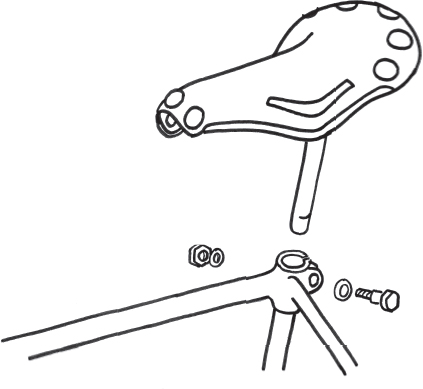
One of the greatest breakthroughs in the evolution of the bicycle was the invention of the bicycle chain, which enables the pedals to be separated from the wheels and in conjunction with the gears allows the pedals to rotate at a different speed to the wheels.

The back-pedal brake is only really found in the Netherlands. Advantages of the back-pedal brake are that it doesnt break very easily and that it requires little maintenance. One disadvantage is that in hilly areas, a back-pedal brake can overheat if you brake hard and often during a descent.
The back-pedal brake is located in the hub of the rear wheel, the hub brake. Inside the hub, there is a screw thread, which pushes up a wedge-shaped disc when you back pedal, so that pieces of metal are pushed out from inside the hub against the hub cylinder. A piece of metal is pushed out from inside the hub against the rotating cylinder and the wheel comes to a standstill.
The advantage of a back-pedal brake is that all of the components are contained within the rear hub and are protected against wind and rain.
Another advantage is that you can cycle and brake without using your hands. (But that can also be a disadvantage, if you actually do it.)
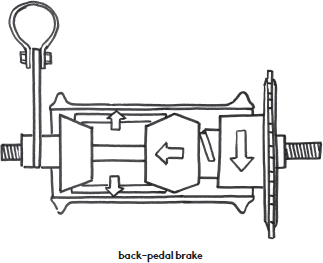
Font size:
Interval:
Bookmark:
Similar books «The Bike Repair Book»
Look at similar books to The Bike Repair Book. We have selected literature similar in name and meaning in the hope of providing readers with more options to find new, interesting, not yet read works.
Discussion, reviews of the book The Bike Repair Book and just readers' own opinions. Leave your comments, write what you think about the work, its meaning or the main characters. Specify what exactly you liked and what you didn't like, and why you think so.

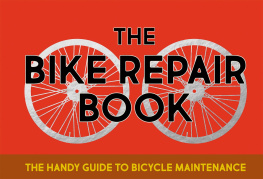



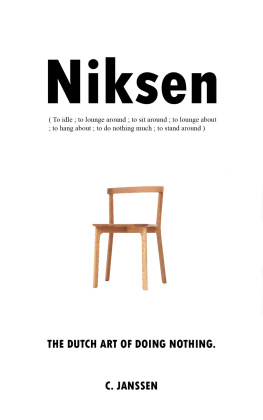
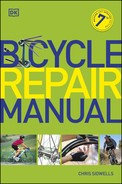

![Shanks - Essential bicycle maintenance & repair: [step-by-step instructions to maintain and repair your road bike]](/uploads/posts/book/235248/thumbs/shanks-essential-bicycle-maintenance-repair.jpg)
